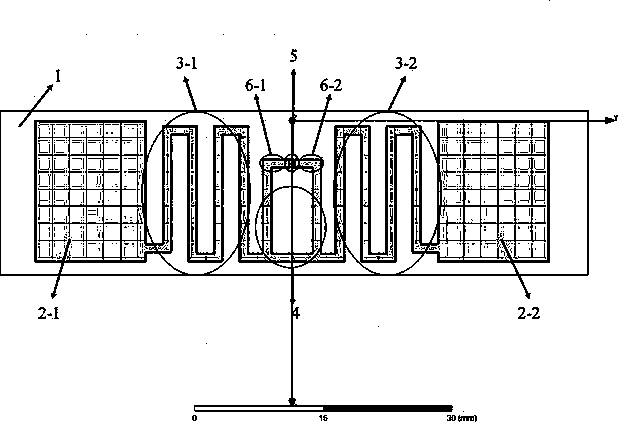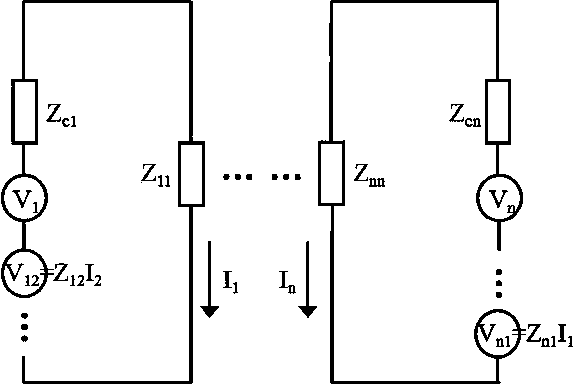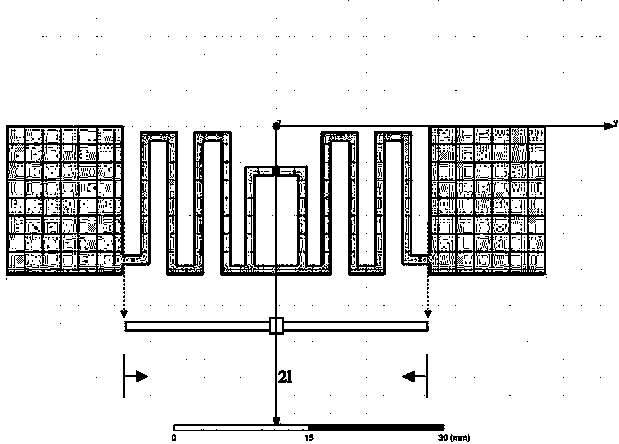RFID (radiofrequency identification) tag applied to intensive distribution scenarios and mutual impedance design method thereof
A technology of RFID tag and design method, applied in the direction of antenna grounding switch structure connection, radiating element structure form, etc., can solve the problems of reducing system work efficiency, missing tag reading, etc., to improve the transmission coefficient, weak mutual coupling ability, and optimize the antenna. gain effect
- Summary
- Abstract
- Description
- Claims
- Application Information
AI Technical Summary
Problems solved by technology
Method used
Image
Examples
Embodiment 1
[0040] see Figure 1~Figure 5 , which is applied to an RFID tag used in a densely deployed scene, including a dielectric substrate (1), a metal microstrip antenna and a chip (5) on it, characterized in that: the structure of the metal microstrip antenna is It consists of a pair of radiation patches (2-1, 2-2), a pair of bent radiation arms (3-1, 3-2) and a resonant matching ring (4); the chip (5) is located in the resonant matching At the center point of the upper frame of the ring (4), a bent radiation arm (3-1, 3-2) and a radiation patch (2-1, 2-2) are respectively connected to the left and right sides of the resonant matching ring (4).
Embodiment 2
[0042] This embodiment is basically the same as Embodiment 1, and the special features are as follows:
[0043] The dielectric substrate (1) is a single-sided rectangular structure made of PET polypropylene; the metal microstrip antenna material is copper, which is made by laser engraving on the copper sheet; the pair of radiation patches (2-1 , 2-2) are rectangular, connected to the bent radiation arms (3-1, 3-2), and symmetrically arranged on both sides of the resonant matching ring (4); the pair of bent radiation arms (3- 1, 3-2) are in the shape of a "bow", with 10 bends on each side, connecting the radiation patch (2-1, 2-2) with the resonant matching ring (4), and bending lines of different lengths can be realized Impedance matching and miniaturization of RFID tags; the resonant matching ring (4) is Π-shaped, wherein the transverse arm is connected to the bent radiation arm, the two transverse arms are connected to the feeder (6-1, 6-2), and the feeder It is soldered to...
Embodiment 3
[0045] The mutual resistance design method applied to the RFID tags in the densely deployed scene is applied to the design of the RFID tags applied in the densely deployed scene according to claim 1, and is characterized in that: the RFID tag mutual resistance design method is adopted , according to the calculation formula to find out the influencing parameters of the RFID tag, and use the Ansoft HFSS simulation software to realize the optimal design of the parameters, so that when the RFID tags are densely deployed, the mutual impedance generated is small. The specific operation steps are as follows:
[0046] 1) Calculate the expression of the transmission coefficient of the RFID tag that needs to be identified under the dense deployment of multiple RFID tags at this time, obtain the influencing factors in the formula, and find out the corresponding RFID tag influencing parameters;
[0047] 2) Select the appropriate chip for RFID label production;
[0048] 3) Realize the opti...
PUM
 Login to View More
Login to View More Abstract
Description
Claims
Application Information
 Login to View More
Login to View More - R&D
- Intellectual Property
- Life Sciences
- Materials
- Tech Scout
- Unparalleled Data Quality
- Higher Quality Content
- 60% Fewer Hallucinations
Browse by: Latest US Patents, China's latest patents, Technical Efficacy Thesaurus, Application Domain, Technology Topic, Popular Technical Reports.
© 2025 PatSnap. All rights reserved.Legal|Privacy policy|Modern Slavery Act Transparency Statement|Sitemap|About US| Contact US: help@patsnap.com



